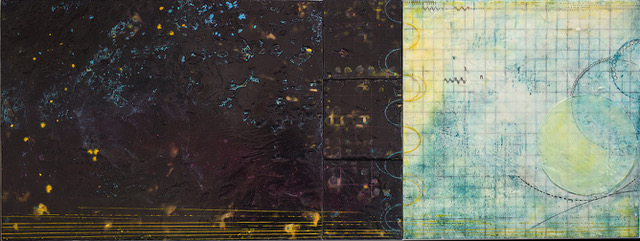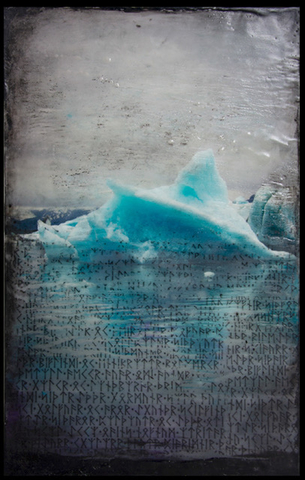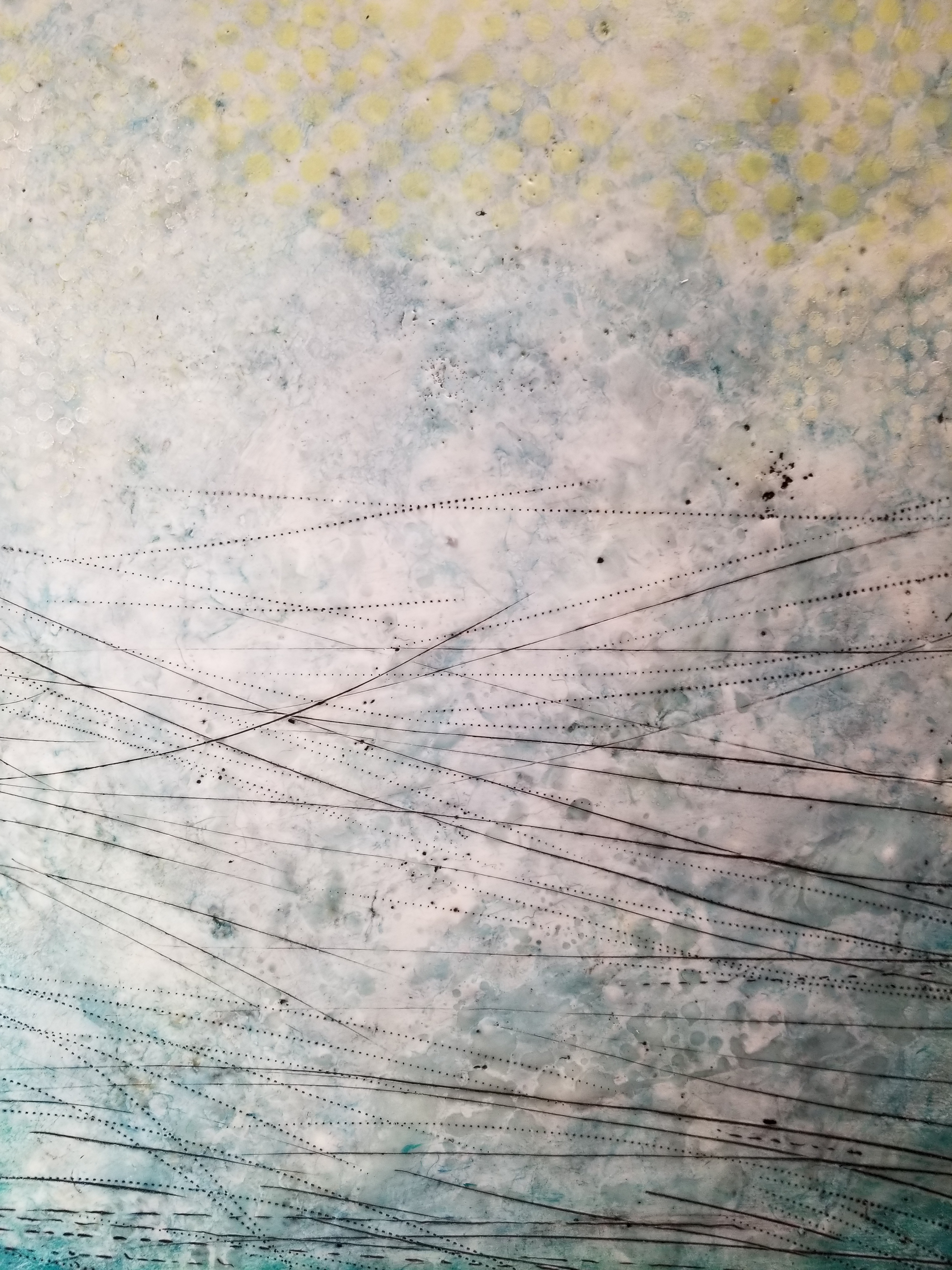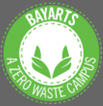- Details
- Published: Monday, 25 February 2019 13:46
Artist Interview: Tina Elkins | Bringing a primal Iceland forth
Inside this exclusive BAYarts interview, Tina Elkins (now showing work with Patty Flauto in the Sullivan Family Gallery for Intuitions) shares why she includes both myths and science into her works of art, gives detailed insight into her encaustic art creation and explains how holding piece of a melting Icelandic glacier inspired her artwork.

This current exhibition has been extremely well-received, and we know you wanted a deeper look into the inspirations behind these pieces. We also wanted to let you get familiar with what encaustic is all about, and there's no better person than Elkins to speak on that.
How was the theme for this exhibition selected?
The over-arching theme of this exhibition is abstract landscapes. Both my show-mate, Patty (Flauto), and I draw upon landscape not only as a subject but also from the more formal attributes of landscape painting that we both like. It is something we both have in common, although our individual styles, techniques and imagery are quite different.
For those unfamiliar with encaustic, can you talk a little bit about how many layers might go into a piece of yours like "Ice Stories" or "Transitions II"? Do you apply image transfers and paint both under and over the wax?
Short answer: there many layers of wax- anything from 6 to 10 total is common; and yes, both- image transfers can be under or over wax. My transfers are usually graphic black line images like the runes in the Odin pieces, and the concentric circle graphic in Study 7.
The Long answer with better explanations: 3 questions- layers of wax, image transfers and paint, so I will address each. Encaustic is a bit different than other paint media. The wax is dimensional and can be either transparent to different degrees or entirely opaque. There are usually at least 2 layers of either clear wax medium or opaque wax paint that serves as a base surface to work on. On top of that could be any number of layers depending on the piece. Four to six is pretty standard for me, but it can just keep going! There is no limit, really- just whatever works. It is also part of the process to work back in and remove layers too, so it makes counting hard!

Tina Elkins - "Transitions II"
Works that have a lot of photo image showing through usually has far fewer layers- too many will obscure the photo. The “Odin” pieces have maybe 2-3 layers of fairly transparent wax over most of the piece and some heavier wax and paint towards the edges. “Ice Stories” actually has a photo print on the bottom layer too! (If you stand back and look carefully you might start to pick out what looks like an underlying structure to the piece- that is the photo). It started with a photo, but as the piece developed it just wanted to keep going, so I followed where it led me! That one has quite a bit of wax and then a lot of thin layers of stencil work on top of that; I really could not count them. “Go Quickly Now” also has a photo base image and a fair number of wax layers – that one is pretty pleasing to me because it uses the photo in such a painterly way- the photo and paint work very closely together. My favorite photo pieces actually stray pretty far from the photo components!
“Transitions” is all wax but actually is not more than 6-8 layers in most of the panels. Unlike the photos that serve as base images, image transfers are usually done on the upper layers of encaustic work, but may still have a couple of layers of wax above them. Mostly I transfer black line images and graphics. The cool thing with image transfers is that imagery can float through layers of wax if you like, or can be on the surface with color layers showing through the image. Oil paint, on the other hand is the dicey part of what I do. Oil paint is highly compatible with wax, and it can be on any layer, but it must be handled with great care. Too much oil will break down the wax and cause cohesion failure. Fusing (applying heat) is required to bind the paint to the wax. Paint can be on any layer if you can adequately bond it to the wax, but good technique in fusing needed. Encaustic is about wax, not oil, but oil is a common companion to wax.
There seems to be both ethereal, atmospheric components to your work, along with quite detailed, scientific portions. Do you feel more drawn towards one end of the spectrum than the other?
I could spend all day on this one, but I will try to be brief. Yes, “ethereal and atmospheric” are primary qualities that I love to explore in my work- that is part of the landscape legacy. Right after grad school I lived in a studio in the flats, and I was mesmerized by the light, fog, and haze that I experienced there along with the scintillating reflections of light off the river- it used to fill my studio with dancing light as the sun reflected off the water. Layers of light and color filled my studio, my field of vision and my imagination- it was literally sublime.

Tina Elkins - "The Sea Forgets its Name"
We have to balance emotional responses and reasoned thought. Life at either end of that spectrum is not that appealing to me- I don’t want to be either so emotional that I am out of control or so rational that all I know is control. Myth, religion and storytelling is one way that people came up with to make sense of things, and science is another. Science is both a method and a tool to explore and understand- and it is beautiful to me too. Science can fill me with the same wonder and awe that a beautiful sunset or vast night sky filled with stars does. I use elements of both myth and science in my work.
Although I am pretty happy to drift in the sea of the sublime, you can’t live on such rarefied air alone- it is good to stay a bit rooted! I like the tension between structure and the ethereal- that is the sweet spot for me. Formally most of my work deals with this balance.
Can you talk about your beautiful Odin-titled pieces (in the Iceland Series) and the Nordic-looking text that overlays them? What are you saying with these, what inspired you?
My family and I visited Iceland this past summer and we drove the southern part of the Ring Road. We also drove off the road and into some pretty incredible places! Iceland brought everything home to me, so to speak. There is a clear sense of immediacy and changeability to the landscape that is not like anything I have experienced before. The forces at work are primal and you can sense it. There is also a sense that the history of both the land and the people are intertwined and ever-present.

Tina Elkins - "The Many Names of Odin"
The photos that make up the Iceland Suite are trying to get at that- the mix of human history with the land itself. Of all of the striking things there, the icebergs that calve off the glaciers was the most astonishing one for me. The sight of them at the Jokusarlon lagoon is unbelievable! I saw them first in the evening in the red-orange summer twilight, then again the next day under a flat metallic gray sky. I fished small bits broken off the icebergs out of the water and held them in my hands- I found it incredible to touch ancient water and watch it melt from my own body heat. Ice is both mighty and fragile at the same time. The ice breaking away from the glaciers is at least a thousand years old, maybe older. I imagine the ice holding the history of Iceland’s earliest settlers, the Viking people. They left Norway seeking a better life, but were met with great challenge and hardship in their new home.
Odin is chief among the ancient Norse gods and he went by many names. These are spelled out in the ancient Norse runes. The runes represent the history of the founding people, as remembered and contained by the ice. "The Many Names of Odin" is a very direct illustration of this- the ice holds the history, and as it melts, a thousand years of human history also melts away.
"The Sea Forgets Your Name" is the title of another piece. The sea is a metaphor for eternity, and also represents the endless and the lost. All of that history eventually joins the sea, and becomes part of a vast ocean of memories.
Where can people find you online or on social media?
I have a public Facebook page: https://www.facebook.com/tinaelkinsart
There are links on FB to my woefully neglected website on Wix:
https://telkins.wixsite.com/tinaelkinsart
I will have to update it now!!
Finally, what does the title of Intuitions mean for you and the work you've displayed in this exhibition?
Intuition is mostly what I go on- I did not choose the title, but it does work. Art, in particular, is an intuitive journey, and I hope as I feel my way around, that the viewers of my work might like to join me.

Tina Elkins - close up of "Make the World Again V"
Intuitions is on display until March 1st, 2019.
Interview conducted and compiled by BAYarts Marketing Manager Jessica Stockdale.
Like it on Facebook, +1 on Google, Tweet it or share this article on other bookmarking websites.


